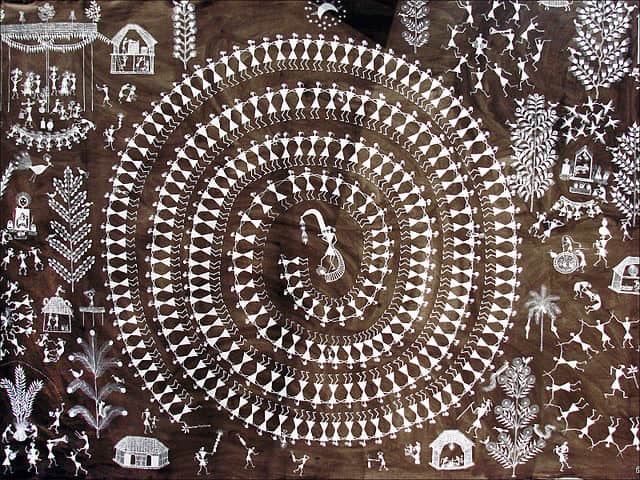Seven tribal mural traditions of India reflect culture, ritual, sustainability, storytelling, and growing global recognition.

India‘s mural tradition is as vast and deep as the mainland itself; remains of rock paintings, cave paintings and geoglyphs are strewn over the country. Yet we have yet to appreciate tribal traditions beyond Warli and Gond traditions. Beyond Warli and Gond, many lesser-known tribal styles hold rich symbolic and spiritual significance across regions. Here are 7 Mural traditions that every Art lover should know about.
Sohrai Murals of Jharkhand
In the villages of Hazaribagh and across Jharkhand, walls turn into living canvases every year with the arrival of Sohrai. During this vibrant festival, women from tribal communities such as the Santhal, Munda, Oraon, and Kurmi gather to create murals that are as meaningful as they are beautiful. Using natural pigments and tools like twigs or even their fingers, they paint directly on freshly plastered mud walls, transforming homes with scenes rich in symbolism.
Timed around Diwali and the harvest season, Sohrai is a celebration of nature and gratitude. The murals feature animals like bulls, elephants, and peacocks—each representing prosperity, strength, and fertility. These figures are surrounded by floral designs and geometric borders, giving the artwork a sense of balance and flow that reflects the rhythms of rural life.
What makes Sohrai special is the way it brings people together. Women sing traditional songs as they paint, and the process becomes a shared ritual tied to the seasons, festivals, and family events like weddings. The designs aren’t sketched or planned—they’re drawn from memory, passed down through generations. This is how knowledge, stories, and cultural identity continue to live on, painted onto walls with care and pride.
These murals may fade over time, but the tradition endures. Sohrai remains a deeply rooted part of everyday life in these communities—an expression of creativity, memory, and connection that is as meaningful today as it was generations ago.
Saura Paintings of Odisha
In the southern districts of Odisha—Rayagada, Gajapati, Koraput, and Ganjam—the walls of tribal homes carry a tradition as old as time. Saura paintings, created by the Saura tribe (also known as Savaras), are not merely decorative; they are sacred visual expressions rooted in ritual and belief.
These paintings are made on special occasions—births, marriages, housewarmings, harvest celebrations, and even funerals. Unlike casual or spontaneous art, Saura murals are deeply ceremonial. They are usually commissioned and painted by priestly artists known as Kudangs, who are responsible for performing the ikon, or ritual drawing, as part of the ceremony.
The visual style is distinctive—stick-like figures of humans and animals arranged in harmonious, rhythmic compositions. Common themes include the Tree of Life, the sun and moon, hunting scenes, and communal dancing, each symbol carrying layers of cultural and spiritual meaning. The paintings are done using natural pigments like red and yellow ochre and white kaolin clay, often set against the backdrop of red earth walls.
What sets Saura art apart is its spiritual function. These murals serve as a medium to communicate with ancestors and deities. Every figure, form, and placement follows a set iconography passed down through generations. It’s not improvised—it’s intentional, respectful, and deeply connected to the life and beliefs of the community.
Saura paintings remain a powerful example of how tribal art in India continues to blend ritual, memory, and identity into one compelling visual tradition.
Bhil Murals of Madhya Pradesh
In the tribal heartlands of Madhya Pradesh—especially in Jhabua, Dhar, and Alirajpur—and extending into parts of Rajasthan and Gujarat, the Bhil community continues to nurture a vibrant mural tradition rooted in memory and meaning.
Bhil murals are instantly recognisable for their use of densely packed dots, each one carrying symbolic weight. These dots are far more than a design choice—they represent stories, ancestral links, and clan identities. Every mural becomes a layered narrative, with motifs that are personal, spiritual, and communal.
Painted with natural dyes using neem twigs, these artworks often feature scenes from tribal myths, depictions of village deities, or celebrations like Holi and Bhagoria. The use of local pigments and organic tools connects the art closely with the land and the people who live on it.
For the Bhil community, painting is a way to preserve stories and honour lineages. Each artwork serves as both a personal expression and a cultural archive, making Bhil murals not only visually compelling but also rich in meaning and tradition.
Pithora Murals – Gujarath
In parts of Gujarat’s Chhota Udepur and Tejgadh, as well as western Madhya Pradesh, the inner walls of tribal homes tell stories that are both sacred and symbolic. These are the Pithora murals, created by the Rathwa, Bhilala, and Bhil tribes as part of elaborate rituals rooted in tradition and belief.
Pithora paintings are never made casually. They are commissioned only after consulting with a shaman and are done to mark significant life events—marriage, childbirth, recovery from illness, or even the loss of cattle. These murals serve as offerings and as acts of devotion, painted to invite blessings and balance.
The visual language is vivid and structured, featuring horses, the sun and moon, ancestral spirits, and Pithora Dev, the central deity. Painted using the five sacred colours, these artworks are always executed by a trained priest-artist known as the Lakhindra, who carries the knowledge and ritual responsibility required for the task.
What makes Pithora murals unique is the way the entire community comes together during the painting process. It’s not just about the art—it’s a spiritual event, accompanied by chants, music, and ritual offerings. The atmosphere is reverent, yet celebratory, making each mural a collective act of faith and memory.
These paintings remain a vibrant expression of tribal identity, a way for communities to connect with their deities, their ancestors, and one another—etched not in stone, but in colour, rhythm, and shared purpose.
Muria and Bastar Mural Traditions- Chattisgarh
In the dense forested lands of Chhattisgarh’s Bastar district, murals are more than decoration—they are sacred expressions of belief, identity, and deep reverence for nature. Among the Muria, Maria, and Dhurwa tribes, mural traditions form a vital part of community and ritual life, closely tied to their animist worldview.
Painted using natural earth pigments like clay, coal dust, and red laterite, these murals often feature bold geometric patterns, animal-human hybrids, and ritual symbols that speak to the spiritual and ecological landscape the tribes inhabit. The artwork frequently appears alongside sculpture and relief work in wood and iron, creating a layered, textured visual language that extends beyond the wall.
These murals aren’t randomly placed. They are usually found around shrines, community halls, or sacred groves known as Dev Gudi—spaces considered vital to tribal spiritual life. Each image serves a purpose, whether to invoke protection, honour deities of the forest, or mark a ceremonial occasion.
Guiding this creative and spiritual process are Sirhas, the shamans and priest-artists of the community. They determine the themes, timing, and execution of the murals, ensuring that the art aligns with seasonal cycles, spiritual needs, and traditional rituals.
Rooted in rhythm, reverence, and the forest itself, the mural traditions of Bastar continue to reflect a world where every brushstroke is a form of devotion and every image is a connection between the seen and unseen.
Santhal Murals – West Bengal and Odisha
Across the tribal regions of Purulia in West Bengal, Mayurbhanj in Odisha, and Dumka in Jharkhand, the Santhal community continues to celebrate its cultural identity through vibrant murals painted on the walls of their homes. These artworks come alive during important occasions like the Baha festival, marriages, and agricultural events, often turning the entire village into a space of visual storytelling.
Traditionally created by women and passed down through generations, Santhal murals use bright natural colours such as red, yellow, and white. The themes reflect everyday life—scenes of music and dance, animals, plants, and folklore—often arranged in narrative panels that tell a complete story across a wall. Each mural becomes a reflection of community memory and seasonal rhythm.
Mural-making is a communal event in Santhal villages. Multiple households participate, with the process often accompanied by folk songs, oral storytelling, drumming, and seasonal rituals. Elders guide the themes, children help with the painting, and sometimes skilled ritual painters are brought in for special occasions. The knowledge is passed down orally, with mothers and grandmothers teaching young girls, while boys may assist during ritual performances.
In recent years, Santhal art has also found new mediums. Artists have begun adapting these murals onto canvas, textiles, scrolls, and paper, allowing the tradition to reach craft fairs, art festivals, and even international exhibitions. However, this shift hasn’t come without challenges. As younger generations migrate to cities and the original ritual context fades, there’s a risk of losing the spiritual and communal essence of the art.
Thankfully, efforts by NGOs and cultural preservation groups are helping sustain interest in Santhal murals. Through workshops, exhibitions, and documentation, they’re supporting tribal artists in keeping the tradition alive—one brushstroke, one story, and one celebration at a time.
Tribal murals preserve ancestral knowledge, from mythology to farming traditions, while promoting eco-friendly art using natural pigments. Today, they inspire designers, support rural tourism, and encourage intergenerational learning. With growing global recognition, these vibrant artworks continue to bridge cultural heritage and contemporary creativity, making them deeply relevant in today’s world.
Read More: Latest



